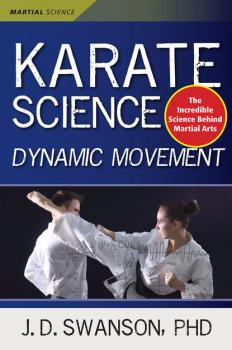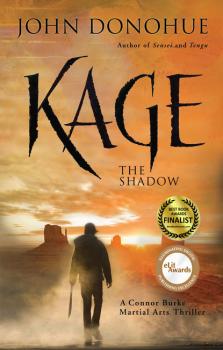MREADZ.COM - много разных книг на любой вкус
Скачивание или чтение онлайн электронных книг.Karate Science
As a lifelong student of martial arts, J. D. Swanson, Ph.D., had searched through piles of books on form and function. Stand here, they said. Step there. But where movement was concerned, not one of them went deep enough. No one discussed dynamics―the actual feeling of the moves. Martial instruction, both in print and in person, tends to focus on stances and finishing positions. But dynamics, motion, sensation…they are karate's connective tissue―and they are the heart of this book. Karate Science: Dynamic Movement will help you understand the mechanics of the human body. Swanson describes these principles in incredible detail, drawing on examples from several styles of karate, as well as aikido, taekwondo, and judo. Whatever your martial background, applying this knowledge will make your techniques better, stronger, and faster. Understand the major types of techniques, including their outward appearances and internal feelings. Master the core principles behind these feelings. Learn the biomechanics and dynamics of core movement. Karate Science: Dynamic Movement is filled with examples, anecdotes, and beautiful illustrations. Although Shotokan karate is the author's frame of reference, the principles of human mechanics translate to all martial styles. This book features Clear and insightful explanations of dynamic movement. Over 100 illustrations. Profound but accessible analysis of the kihon, or fundamentals of Shotokan karate. “ Karate Science: Dynamic Movement is rooted in the teachings of the masters,” Swanson says. “This book nucleates that knowledge, clarifying and distilling the key principles behind movement dynamics. This is the next evolution of karate books.”
Kage
In the seemingly trackless waste of the desert outside Tucson, Arizona, a coyote cross border smuggler is found dead, another victim of the escalating violence on the southwest border. At the same time, a mysterious best-selling writer's death deepens the controversy surrounding his works. Rumors surround the late Elliot Westmann, with dark hints of mystic vendettas and a confrontation with an assassin sent to punish Westmann for violating a code of secrecy in his books. Westmann's daughter hires Connor Burke to assist in unraveling the mystery of her father's death, which the police have labeled as accidental. He is led from the scholarly assessment of Westmann's work to the investigation of Xochi, a magnetic young student of ancient Native cultures and secret trails across the desert. In the withered and unforgiving landscape of the Southwest, Connor Burke works to pierce the cloud of mystery surrounding Westmann, his work, and a cryptic manuscript that has captured the deadly interest of rival smuggling gangs. Borders are dangerous, and as he uncovers clues suggesting the real reasons why Westmann was killed, he places himself and those he loves in deadly peril. Burke's only hope to solve this mystery is to appeal for the aid and guidance of his teacher, Yamashita. That won't be easy this time. Kage builds on the characters and plots of the previous Burke novels Sensei , Deshi , and Tengu . It advances the ever-deepening relationship between student and teacher while weaving in time-honored themes of the martial arts— conduct, ordeal, and courage, with events as current as today's headlines.
Fight Like a Physicist
An in-depth look into the physics behind martial arts. Whether you are an experienced martial artist or a curious enthusiast, this book gives you an “unfair advantage” by unraveling the complex science of effective fighting techniques and examining the core principles that make them work. Did you know? Momentum is for knocking people over Energy is for breaking bones and causing pain A haymaker travels 3.14159 times farther than a jab You are only an “object” when you are rigid Fight Like a Physicist blends inquiry, skepticism, and irreverent humor—all while punching holes in myth and mysticism. Highlights include Making physics your “unfair advantage,” in the ring and on the street Examining center of mass, pi, levers, wedges, angular momentum, and linear momentum for martial artists Reducing traumatic brain injury in contact sports Exposing the illusion of safety provided by gloves and helmets Overturning conventional wisdom on compliance during an assault Busting up Hollywood action clichés Fight Like a Physicist reads like a manifesto on the rational practice of martial arts. It’s intelligent, fun, and dangerous—and nothing short of iconoclastic.
Facing Violence
Survival Favors the Prepared Mind —Robert Crowley This book stands alone as an introduction to the context of self-defense. There are seven elements that must be addressed to bring self-defense training to something approaching ‘complete.’ Any training that dismisses any of these areas leaves you vulnerable. 1. Legal and ethical implications. A student learning self-defense must learn force law. Otherwise it is possible to train to go to prison. Side by side with the legal rules, every student must explore his or her own ethical limitations. Most do not really know where this ethical line lies within them. 2. Violence dynamics. Self-defense must teach how attacks happen. Students must be able to recognize an attack before it happens and know what kind they are facing. 3. Avoidance. Students need to learn and practice not fighting. Learning includes escape and evasion, verbal de-escalation, and also pure-not-be there avoidance. 4. Counter-ambush. If the student didn’t see the precursors or couldn’t successfully avoid the encounter he or she will need a handful of actions trained to reflex level for a sudden violent attack. 5. Breaking the freeze. Freezing is almost universal in a sudden attack. Students must learn to recognize a freeze and break out of one. 6. The fight itself. Most martial arts and self-defense instructors concentrate their time right here. What is taught just needs to be in line with how violence happens in the world. 7. The aftermath. There are potential legal, psychological, and medical effects of engaging in violence no matter how justified. Advanced preparation is critical. Any teacher or student of self-defense, anyone interested in self-defense, and any person who desires a deeper understanding of violence needs to read this book. We strongly recommend this book to anybody wishing to learn self-defense, or understand how to stay safe should violence rear it's ugly head
Even if it Kills Me
"…charmingly eccentric memoir detailing a bassist's marital arts journey."—KIRKUS REVIEWS "…a story about honest, integrity, and hope…wildly entertaining."—DANNY KAVALDO, WORD-RENOWNED FITNESS TRAINER «…for the little guys in the small towns…for self-believers…for fighters.»– ZACHARIAH BLAIR, LEAD GUITARISTS, RISE AGAINST «…never-surrender ethos that make guys like this lifers.»– MIKE GITTER, VP OF A&R, CENTURY MEDIA RECORDS This is the true story of a rock and roll musician who takes up taekwondo at forty years old. Doni Blair, bassist for the Toadies, knows he’s past his physical prime, but he’s determined to push himself and pursue his dream of becoming a martial artist—even if it kills him. As a kid Doni was obsessed with ninjas and kung fu movies. He and his brother took up taekwondo—there was no ninja school in Sherman, Texas. Classes were expensive, especially considering their parents’ tenuous employment status and fondness for alcohol. The family lived like “white-trash gypsies,” Blair writes, adding that he got good at moving furniture at three in the morning. The Blair kids loved taekwondo, but the family just couldn’t afford classes. Doni walked away from martial arts. Thirty years later, he’s walking back. “I’m not a kid anymore,” he writes. “I’m a middle-aged man trying to come to grips with being a middle-aged man. I’m not as fast as I used to be. It takes longer for the injuries to heal. I have to eat more bran.” Doni discovers the road to black belt is rough and, well, weird. He meets martial seekers of every sort. He has run-ins with a teenage savant who seems determined to break the author’s leg. He drives a van full of seven-year-olds for the dojang’s after-school program. They puke everywhere. Even If It Kill Me is smart and funny, introspective and irreverent. It blends rock and roll and taekwondo—two of the coolest things in the world.
Defensive Tactics
Whether you are a law enforcement officer seeking to improve your edge or a martial artist wanting to expand your knowledge of street-proven techniques, you will find Defensive Tactics: Street-Proven Arrest and Control Techniques is filled with invaluable information to prepare you for even the most difficult scenarios. Highlights include: Joint manipulation that works Leverage control vs. pain control Striking with the hands, feet, forearms, and elbows Safely and quickly crossing the gap Blocking an assailant’s strikes Using vulnerable points to gain compliance Head disorientation Safe application of carotid constriction or “sleeper” holds Controlling a suspect on the ground Arresting big guys Fighting concepts to take on patrol Weapon retention in close quarters and on the ground Loren W. Christensen is a retired cop and high-ranking martial artist who survived everything the mean streets threw at him, working patrol, gang enforcement, and dignitary protection. Defensive Tactics goes beyond what is taught in the academy, during an officer’s in-service training, and what is allowed by the administration. This book also includes a chapter on proven ways to control a suspect on the ground, written by LAPD officer Mark Mireles, an MMA coach, police academy trainer, and champion wrestler.
Brain Fitness
In Brain Fitness Dr. Aihan Kuhn shares her expertise in tai chi, qigong, and medicine, giving readers exercises designed to prevent brain aging. This book represents a synthesis of Dr. Kuhn’s studies in martial arts as well as Eastern and Western healing. Tai chi and qigong practitioners around the world have long known that these arts promote fitness and self-defense. In this book Dr. Kuhn discusses their physical, mental, emotional, and spiritual benefits. She emphasizes how tai chi and qigong aid in memory, emotional balance, and lifelong learning. This book features: An illustrated manual detailing tai chi and qigong exercises to prevent brain aging Elements of Eastern and Western medicine combined to form a new vision of brain health Dr. Kuhn’s concise, accessible guidance from a lifetime of studying martial arts and medicine With this book you will: Learn Dr. Kuhn’s keys to prevent brain aging Discover the physical, mental, emotional, and spiritual benefits of tai chi Learn how tai chi and qigong assist in human healing Dr. Kuhn says we have long assumed that getting older means facing a decline in memory, attention span, numerical ability, creativity, alertness, learning ability, and language. " But we were wrong ,” she adds. “ New findings from science show that if the brain is consistently stimulated, no matter at what age, the brain can remain young and healthy. ” She has written Brain Fitness to help us all maintain that clarity, creativity, and vitality.
The Town's Inheritance
The sheriff of Pine Falls, Nebraska, has his hands full. When Ernie Rucker passed away, he left his house and money to the town. It was put into a trust in the sheriff’s name with the specification that it be spent to benefit the community. The men in Pine Falls and surrounding area far outnumbered the women. When the sheriff learned the plight of eight desperate young ladies back east with nowhere to live, it caught his attention. He could bring the ladies to Pine Falls. It seemed like a perfect match, but once he set the wheels in motion, nothing seemed to go as planned. WARNING: The Town's Inheritance is a sweet romance set in the late 1800s that includes elements of domestic discipline. If the spanking of adult women upsets you, please do not purchase this book.
The Dreamed Part
Following his failure to break into the Hadron Collider and merge with the so-called “God particle,” The Writer from The Invented Part can no longer write or sleep. Instead, he lies awake, imagining and reimagining key moments of his life, spinning out a series of insomniac visions every bit as thought-provoking as they are dreamlike. A mysterious foundation dedicated to preserving dreams, suddenly invaluable in the wake of the dream-eradicating White Plague; a psycho-lyrical-photophobic terrorist; an electric and mercurial lullaby; three lunatic sisters (and an eclipsed brother) who write from the darkest side of the most wuthering lunar heights; a hallucinating prisoner and a hallucinatory family; a genius addicted to butterflies and an FBI agent addicted to that genius; a looney and lysergic uncle and parents who model but are not model parents; a revolutionary staging of Shakespeare for the children of chic guerrillas; a city of sleepless bookshops; and a writer who might be 100 years old. Or not. With characteristic wit, careening style, and array of cultural references, high and low and everything in between—from Shakespeare, the Brontë sisters, and Vladimir Nabokov to Talking Heads, superhero movies, and Rick and Morty—the second volume of Fresán’s trilogy is one of the most ambitious, unique, and entertaining novels of our time.
The Incompletes
•Argentinian fiction is having a particular moment, with the success of Roque Larraquy, Rodrigo Fresán, Samanta Schweblin, and César Aira likely to help Chejfec reach a larger audience<br><br>•Heather Cleary’s translation will draw more attention after making the National Book Award for <i>Comemadre</i><br><br>•Fourth book by Chejfec to be published by Open Letter <br><br>•Hits on the timely issue of being a global, versus a nationalized, citizen<br><br>•Chejfec lives in NYC, teaches at NYU, and is able to do some events









